There’s a lot of material on Robotics and Deep Learning out there. In this list I’m going to concentrate on the work I’ve found most helpful.
Learning about Deep Learning
Free Udacity Course on Machine Learning
 Deep Learning is heavy on maths and probability theory. Rather than diving in directly, I recommend first taking this introductory course on machine learning, which deals with standard methods for regression, classification and so on. This a great, free, accessible course by Sebastian Thrun and Katie Malone that doesn’t require a lot of previous maths. It’s also extremely practical; I did my first commercial machine learning project with scikit-learn directly after finishing the course. With this under your belt, the deep learning materials will be far more understandable.
Deep Learning is heavy on maths and probability theory. Rather than diving in directly, I recommend first taking this introductory course on machine learning, which deals with standard methods for regression, classification and so on. This a great, free, accessible course by Sebastian Thrun and Katie Malone that doesn’t require a lot of previous maths. It’s also extremely practical; I did my first commercial machine learning project with scikit-learn directly after finishing the course. With this under your belt, the deep learning materials will be far more understandable.
Learning ROS
ROS has an insanely steep learning curve, which I hope to do something about one day. I haven’t found a definitive introduction to ROS, which I think is more down to ROS rather than the quality of the books. Try the ROS tutorials and then check out the best books I’ve come across:
ROS by Example
 I found Patrick Goebel‘s ROS By Example Vol. 1 to be useful. There is also a volume 2. He updates it with each ROS release, so check here first to see if there’s a new version for Jade or Kinetic. Oh, and buy the PDF version rather than the hard copy as you’ll be doing a lot of copying and pasting.
I found Patrick Goebel‘s ROS By Example Vol. 1 to be useful. There is also a volume 2. He updates it with each ROS release, so check here first to see if there’s a new version for Jade or Kinetic. Oh, and buy the PDF version rather than the hard copy as you’ll be doing a lot of copying and pasting.
Mastering ROS for Robotics Programming
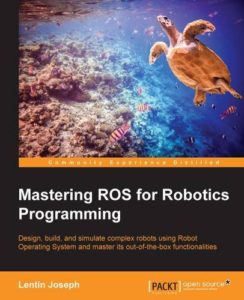 Lenin Joseph’s Mastering ROS for Robotics Programming is in some ways more advanced than Goober’s book, focusing more on C++ than Python, but it also has better coverage of Gazebo. The book could have used a professional editor as the English is occasionally clumsy, but the material is good. It assumes you’ve already done the ROS tutorials.
Lenin Joseph’s Mastering ROS for Robotics Programming is in some ways more advanced than Goober’s book, focusing more on C++ than Python, but it also has better coverage of Gazebo. The book could have used a professional editor as the English is occasionally clumsy, but the material is good. It assumes you’ve already done the ROS tutorials.
Learning about Robotics
Free Udacity Course on Artificial Intelligence for Robotics
 Another great free Udacity Course by Sebastian Thrun that is light on the maths required, but introduces all the core algorithms for probabilistic robotics. Doing this course will let you understand how the ROS Navigation Stack actually works without having to plough through the much denser Probabilistic Robotics book.
Another great free Udacity Course by Sebastian Thrun that is light on the maths required, but introduces all the core algorithms for probabilistic robotics. Doing this course will let you understand how the ROS Navigation Stack actually works without having to plough through the much denser Probabilistic Robotics book.
Vehicles – Experiments in Synthetic Psychology
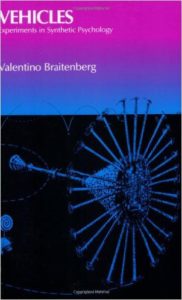 Seminal work by Valentino Braitenberg in 1984 is still the best book I’ve ever read on robotics (particularly the first half) and totally relevant today. Unlike other long-winded academic works, you can polish this off in an afternoon. An invaluable corrective for those who take ROS-like solutions at face value and blather on about inverse kinematics.
Seminal work by Valentino Braitenberg in 1984 is still the best book I’ve ever read on robotics (particularly the first half) and totally relevant today. Unlike other long-winded academic works, you can polish this off in an afternoon. An invaluable corrective for those who take ROS-like solutions at face value and blather on about inverse kinematics.
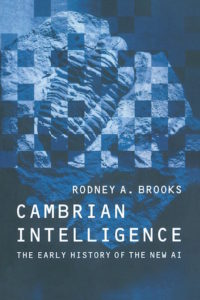 Cambrian Intelligence
Cambrian Intelligence
The best of Rodney Brooks and his subsumption architecture. Read in conjunction with Vehicles to see where so-called Embodied Cognitive Psychology came from.
Understanding Intelligence
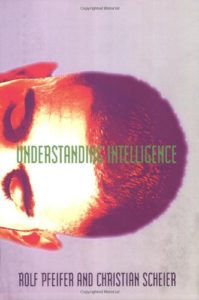 Academic text book from 2001 by Rolf Pfeifer and Christian Scheier summarises the thinking on the “embodied” strain of robotics inspired by Brooks and Braitenberg. It’s a little old, but still pretty much reflects the state of the art, which shows how unfashionable this branch is. Like many academic books it suffers from long-windedness, as in “first I’ll tell you what I’m going to tell you, then I’ll tell you, then I’ll tell you what I told you”. The 700 page length could have been cut by at least a third without a problem. Contrast that with what you’ll learn with an afternoon in the company of Braitenberg. That aside, it’s still a very good summary, there’s lots of fascinating work to take in and it’s basically right on the money in terms of how robots should be architected.
Academic text book from 2001 by Rolf Pfeifer and Christian Scheier summarises the thinking on the “embodied” strain of robotics inspired by Brooks and Braitenberg. It’s a little old, but still pretty much reflects the state of the art, which shows how unfashionable this branch is. Like many academic books it suffers from long-windedness, as in “first I’ll tell you what I’m going to tell you, then I’ll tell you, then I’ll tell you what I told you”. The 700 page length could have been cut by at least a third without a problem. Contrast that with what you’ll learn with an afternoon in the company of Braitenberg. That aside, it’s still a very good summary, there’s lots of fascinating work to take in and it’s basically right on the money in terms of how robots should be architected.
Pfeifer has a newer book covering almost exactly the same material with some added nonsense about “intelligent companies”. This one is better.
Loving the Machine
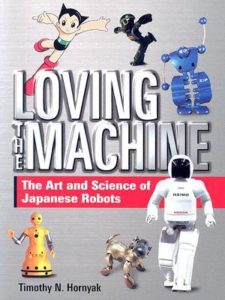 Don’t just stick to technical works; this lovely out-of-print book by Timothy Hornyak, an ex-pat clearly enamoured of Japanese culture deals with the history of Japan’s love affair with robots, and why they may get to lead the world. Great stuff on mechanical dolls, Astro Boy and keyboard-playing robots from the seventies.
Don’t just stick to technical works; this lovely out-of-print book by Timothy Hornyak, an ex-pat clearly enamoured of Japanese culture deals with the history of Japan’s love affair with robots, and why they may get to lead the world. Great stuff on mechanical dolls, Astro Boy and keyboard-playing robots from the seventies.
Interesting Research
Deep Learning and Manipulation
This is an area of particular personal interest and wide open for innovation.
Berkeley Work on Deep Learning and Manipulation
NOTE 4th June 2016: the video appears to have been removed which is a real shame. I suspect it was taken down by the speakers themselves as I can’t see any other grounds for a “copyright violation”. You can still watch it here, so do so quickly before it’s taken down again!
Excellent talk on work at Berkeley for applying Deep Learning to the manipulation problem. It’s annoying how Chelsea Finn is consistently interrupted more often than Sergey Levine. See also this video of the experiments and the associated and far denser papers Deep Spatial Autoencoders for Visuomotor Learning and End-to-end Training of Deep Visuomotor Policies.
Sergey Levine has since pursued Deep Learning for manipulation at Google using 14 robot arms working on the same model (paper, video).
Locomotion
Designing Robots to Walk and Run
Cool talk on making robots walk naturally by Jonathan Hurst. How to offload much of the hard calculations behind walking into the physics of the system. Generally there’s too much focus on the mind, not enough on the body, probably because there’s an over-abundance of software types like me.